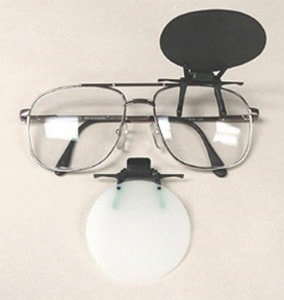Blinders can combat a multitude of different problems you may encounter on the range or trap line. Side blinders keep wind and debris from bothering your eyes, help stop the glare from creeping into your vision, and can keep you focused on a specific direction. There are drawbacks, however. Your peripheral vision is essentially non-existent when dawning on side blinders. If you are someone who frequently traps shoots or are in events where situational awareness is key, then wearing a pair would not do much to help you reach your full potential.
Is There More Than One Style of Blinders?
There are two styles of blinders. Most typically if you see them on a person, they will be wearing side blinders. But there are also flip-up blinders most commonly used for shooting competitions where precision is the goal. For now, we will focus on side blinders and the effect they have on trap shooting. Trap shooting emphasizes a large amount of focus on a specific area. An accepted standard in the world of trap shooting is to pick a spot in your target’s flight path and wait until your bead intersects with the clay pigeon. Most would not track the clay pigeon and take a shot with their weapon still moving on the target. Therefore, waiting for the clay is essential for success. This is where the blinders can come in handy as they can help you focus on a generalized area.
If you already know the trajectory of your clay, then side blinders can be a great tool to hone your focus. If you are standing on a shooting line, that’s where the limitations begin to show. Even if you have the throwing box clear in your field of vision, there is still a possibility it can throw a clay pigeon past your blinders. Wasted time ensues as you’re trying to reacquisition on the target, losing precious seconds that mean everything in trap shoots. If you’re in an area where strong wind or an overbearing sun hanging on your side is a major concern, side blinders offer relief from annoying conditions. Some can be adjustable as well so you can set what they’re actually keeping away from your eyes. Keeping them far back helps with reducing the glare encountered in well-lit areas.
What Can Flip-up Blinders do For My Performance?
 Flip-up blinders are more for precision shooting and don’t really have a use on a conventional range or trap line. Common practice is to block your off eye and let your dominant eye take over. This breeds the best results as your eye will have a hard time wandering to another point to focus on. If done properly, your target and front sight should hold a crisper picture than if you were just looking at it with two un-obscured eyes. However, you must be wary of what blinders you choose to buy. Some will not meet your expectations as you thought they would.
Flip-up blinders are more for precision shooting and don’t really have a use on a conventional range or trap line. Common practice is to block your off eye and let your dominant eye take over. This breeds the best results as your eye will have a hard time wandering to another point to focus on. If done properly, your target and front sight should hold a crisper picture than if you were just looking at it with two un-obscured eyes. However, you must be wary of what blinders you choose to buy. Some will not meet your expectations as you thought they would.
While there are a good amount of flip-up blinders on the market, people also make their own special take on the product. Blinders can be fashioned from really anything, but if you want to buy a pair on the market, it’s recommended you purchase some that attach to the bill of your hat or on the rim of your glasses. Most shy away from black or darker blinders as they muddle the target and make it harder to see their sights. Translucent or white blinders that let in a lot of light help people make out their iron sights a little better as well as also painting a clearer target in front of them.
Blinders Final Thoughts
If you are having trouble focusing on your front sight, want to see your target with a little more clarity, or just tired of having the glare of the sun in your eyes, then blinders may be something to consider. With flip-up blinders, translucent shields are always going to better suit your eyes than ones of solid colors. Side blinders can work wonders for your focus, but in a situation where your peripheral is needed, it would more than likely be better to leave them in your shooting bag.
Footnotes:
Below are links to a few blogs that shed some light on the usage of both side and flip-up blinders.

